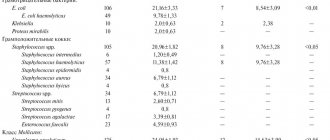September 24, 2021
Dysentery (shigellosis) is an intestinal infection caused by bacteria of the Shigella genus, occurring with primary damage to the distal colon and symptoms of intoxication
Dysentery (shigellosis) is an intestinal infection caused by bacteria of the genus Shigella, occurring with primary damage to the distal colon and symptoms of intoxication. Shigella bacteria pass through the digestive organs and become established in the lining of the large intestine. By their presence, they provoke an inflammatory reaction, resulting in a disruption of the normal balance of the local flora.
The mechanism of transmission of infection is fecal-oral, which is realized through contact, household, food and water routes. Factors of transmission of the infectious principle can be unwashed hands, contaminated household items, various food products, especially dairy, and water from open water sources. Dysentery is widespread everywhere, but especially where food preparation technology is violated, finished products and water sources are contaminated.
People of all age groups are affected, but those most susceptible to this disease are those with severe immunodeficiency and trophic insufficiency, as well as preschool children. A seasonal increase in incidence is observed in the summer and autumn. Waterborne and foodborne dysentery outbreaks can occur at any time of the year.
The causative agent of dysentery can cause one of the common forms of the disease. In modern medicine, there are such varieties as: acute (colitic or typical) and gastroenteric (atypical);
chronic (continuous and recurrent); bacteriological (convalescent and subclinical). Signs of the disease usually begin to appear a couple of days after infection, but symptoms may appear within a period of several hours to 5-6 days.
In what cases is culture for intestinal pathogens usually prescribed?
Intestinal infections are transmitted from person to person through environmental objects, water, and food. The mechanism of transmission is fecal-oral through food, water and dirty hands. The incubation period lasts from several hours to 2 days.
If the following symptoms appear: nausea, vomiting, frequent loose stools (there may be blood in the stool), abdominal pain and elevated body temperature, you must undergo a stool culture test to determine the type of infectious agent. The study is carried out before the start of antibacterial therapy.
For epidemiological purposes, the analysis is used when conducting preventive examinations for employment in the public service sector: catering establishments and medical institutions. This is necessary to identify asymptomatic bacterial carriage and in cases of erased chronic, atypical forms of these infections, when the carrier himself does not experience symptoms of the disease, but can infect others.
Symptoms of dysentery
Based on the degree of severity, there are mild, moderate, severe and very severe forms. The disease, as a rule, begins with the appearance of abdominal pain, followed by stool disorder. The most complete signs of dysentery are presented in the moderate form of the disease. Characterized by an acute onset, fever with chills (up to 38–39 °C), which lasts 2–3 days. Worried about weakness, headache, loss of appetite.
Intestinal disorders occur in the first 2–3 hours from the onset of the disease and are manifested by discomfort in the lower abdomen, rumbling, periodic, cramping pain in the lower abdomen, the frequency of stool varies from 10 to 20 times a day. The stool initially has a fecal character, then an admixture of mucus and blood appears, the volume of feces decreases, they can take on the appearance of spit - mucus and blood. There is an acute urge to defecate. The skin becomes pale, the tongue becomes covered with a thick brown coating. From the cardiovascular system, rapid heartbeat and decreased blood pressure are noted. The most characteristic signs are spasm and pain when palpating the left iliac region.
In the typical classical course of dysentery, the leading symptom complex is colitis. Patients complain of cutting, cramping pain in the abdomen, localized in the iliac regions, more on the left, the intensity and duration of which depend on the form and severity of the disease. The urge to defecate is often fruitless and is accompanied by excruciating nagging pain in the rectal area – tenesmus. In severe forms of shigellosis, an increase in stool frequency up to 20–30 times a day or more is observed. Defecation, as a rule, does not bring relief.
In the first hours of the disease, the stool is quite copious, semi-liquid or liquid, often mucous. The stool may take on the appearance of meat slop, which may later contain an admixture of blood and pus (“rectal” or “dysenteric spit”). In severe forms of acute dysentery, all the symptoms are more pronounced: very frequent stools mixed with mucus, blood and pus; vomiting and nausea are observed; body temperature remains at high levels for a long time. In the absence of adequate treatment of the disease, it becomes chronic.
In children, dysentery is more severe. The stool may be copious, with lumps of gray-green mucus appearing in it. The child's body becomes severely dehydrated. In severe cases of dysentery, the baby may develop cardiovascular failure, convulsions, and disturbances of consciousness.
With adequate treatment and under the supervision of a doctor, the disease, as a rule, ends in recovery with complete restoration of the impaired functions of organs and systems; recovery on average occurs 2-3 weeks from the onset of the disease. However, late seeking medical help and inadequate therapy can lead to the disease becoming chronic, and more often to the development of so-called post-dysentery conditions. They manifest themselves in the form of functional disorders of secretion and motility of the gastrointestinal tract.
There are two forms of chronic dysentery - recurrent and continuous. Continuous chronic dysentery leads to the development of severe digestive disorders and organic changes in the mucous membrane of the intestinal wall. Intoxication symptoms in continuous chronic dysentery are usually absent, there is constant daily diarrhea, stools are mushy and may have a greenish tint. Chronic malabsorption leads to weight loss, hypovitaminosis, and the development of malabsorption syndrome.
What exactly is determined during the analysis process?
The growth of pathogens of dysentery and salmonellosis, if present, is detected. Since special selective media are used specifically for these groups of microorganisms, the growth of other bacteria in this study is unlikely.
Other groups of microorganisms capable of causing acute intestinal infections (for example: pathogenic species of Escherichia coli E. coli) do not grow in this culture.
Laboratory test “DNA of intestinal pathogens in stool: OKI test (Shigella/Salmonella/Campylobacter/Adenovirus/Rotavirus/Norovirus/Astrovirus)”. will allow, along with bacteria, to identify viruses that can cause intestinal infections.
Also, if salmonellosis is suspected, the test “Antibodies to Salmonella (Salmonella) A, B, C1, C2, D, E” in the blood serum is used.
Coprogram: senseless and merciless
Coprogram (general stool analysis) is one of the most common tests in a domestic children's clinic or hospital. If you open the medical history of a patient with ARVI, tonsillitis, or even a traumatic brain injury, there, along with a clinical analysis of blood and urine, you will definitely find a coprogram. Most doctors have become so accustomed to this since Soviet times that the question does not even occur to them: why, in fact, stool microscopy in the treatment of otitis media or pneumonia?
We sometimes see the same picture in outpatient settings. Let’s say the child is healthy, gaining weight well, and has normal stools—it seems, what else is needed for happiness? Of course, it is a coprogram, which pediatricians must prescribe to all healthy infants at least twice, without any indication.
According to the “protocol,” the coprogram is the most important diagnostically significant analysis and is used to diagnose various diseases of the gastrointestinal tract (GIT).
Prevention and treatment of dysentery
Treatment of dysentery can be carried out at home or in a hospital (in case of moderate or severe form of the disease). Hospitalization is also necessary for people with severe concomitant, chronic pathologies.
Treatment consists of taking antibiotics, specific dysentery bacteriophages, strict bed rest and a special diet (table No. 4) with low-fat broths, chicken meat, lean fish, jelly, porridge, green tea, rosehip decoction.
Prevention of the disease is strict adherence to personal hygiene, medical examination of people working in public catering establishments, constant monitoring of water sources, public reservoirs, swimming pools, food establishments, etc.
When is a test for dysbacteriosis prescribed?
Analysis for dysbacteriosis is prescribed:
- in case of intestinal dysfunction - with frequent or prolonged constipation or diarrhea, flatulence and abdominal pain;
- with intolerance to certain foods, allergic reactions (skin rashes);
- for intestinal infections;
- against the background of hormonal therapy or long-term treatment with antibiotics;
- newborns at risk;
- children and adolescents who often suffer from ARVI.
A test for dysbacteriosis can be prescribed by a general practitioner (general practitioner, family doctor, pediatrician) or gastroenterologist.
How to get tested for dysentery at JSC SZTsDM
Only early detection of Shigella infection guarantees minimal health risks and a speedy recovery. Therefore, at the first signs of malaise and as a preventive measure, it is necessary to undergo laboratory tests for infection with the causative agent of shigellosis.
This is easy to do in the divisions of JSC SZTsDM. Using the interactive map, you can determine the research point closest to you and choose a convenient time. You can make an appointment with a doctor on the website or through the call center.
All our laboratories employ qualified employees, use modern research methods and guarantee complete safety of your health and the safety of your personal data.
Sources of infection, mechanisms of transmission
The source of infection is a person suffering from various forms of dysentery, including asymptomatic ones. Infection occurs through contact, household, water and food routes. People of all age groups are affected; those with weakened immune systems and preschool children are most susceptible. People with dysentery are dangerous to others almost immediately after infection and throughout the entire period of convalescence (recovery). If the disease becomes chronic, the release of the pathogen occurs over months. It should be noted that people have different susceptibility to the disease.
Methods for laboratory diagnosis of dysentery
program
- this is an analysis of feces: its composition, properties, impurities. With shigellosis, inclusions of mucus, accumulations of leukocytes more than 20-30 per field of view, red blood cells and epithelial cells are found in the stool.
General blood analysis
In severe forms of shigellosis, the following changes are noted:
• leukocytosis with a neutrophil shift to the left;
• toxic granularity of neutrophils;
• increase in ESR;
Bacteriological culture
This is the leading specific method for diagnosing dysentery, which involves inoculating stool on special nutrient media to isolate pathogenic bacteria. Bacterial culture is used as a confirmatory test because its results are known only after 2-5 days. However, it is extremely important for accurate diagnosis and determination of sensitivity to antibacterial drugs. Based on the results of the study, the doctor adjusts the treatment
Serological study
The task of serological diagnosis is to determine specific antibodies in the blood to the main types of Shigella. For analysis, the indirect hemagglutination reaction (IRHA) is used. Red blood cells with Shigella antigens of different species are added to the diluted blood serum in the laboratory. After a day, the result is ready: if the samples contain specific immune antibodies to Shigella, agglutinins are formed. Antibodies in dysentery appear at the end of the first week of illness and reach a maximum on days 21-25, then the antibody titer decreases. Therefore, it is advisable to use the paired serum method, that is, examine two blood samples taken with an interval of 10-14 days. An increase in antibody titer by four or more times has diagnostic significance.
Polymerase chain reaction (PCR)
– consists of identifying Shigella DNA fragments in feces. This is a fast and reliable research method.
Sigmoidoscopy
This is an instrumental diagnostic method, which is carried out using a proctoscope inserted into the patient’s anal passage. Using an eyepiece, the doctor assesses the condition of the mucous membrane and determines changes characteristic of dysentery.
Preparation for stool analysis for dysbacteriosis
3-4 days before the test, you must stop taking laxatives. You should also not use rectal suppositories.
If you have undergone an X-ray examination of the stomach or intestines with the introduction of a radiopaque substance, you will need to wait until it is completely removed from the body and only then collect material for analysis. Also, material obtained by enema is not suitable for analysis.
Dysentery (shigellosis)
A bacteria called shigella causes dysentery (shigellosis). You can become infected through food, such as raw vegetables. The main symptoms of this disease in the acute period:
- diarrhea (diarrhea) with blood or mucus,
- abdominal cramps,
- nausea or vomiting
- temperature above 38˚C.
Shigellosis goes away on its own - you just need to drink more and preferably oral rehydration solutions, which are sold at any pharmacy. You can take paracetamol to relieve pain and reduce fever. Antidiarrheal drugs like loperamide can make the situation worse. Only in rare severe cases are antibiotics prescribed.
Shigella infection occurs through the fecal-oral route. And if a person does not wash his hands after using the toilet and touches the products, the consumer of these products also becomes infected with an intestinal infection.
Can a person remain infectious outside the acute period? After the last episode of diarrhea, doctors advise not to go to work for another 48 hours, as the risk of transmission of infection during this time is high. In some cases, bacteria can live in the body for another 3-4 weeks after recovery.
Why do you need an analysis for dysbacteriosis?
To confirm that health problems are caused by dysbiosis, it is necessary to do a dysbiosis test.
Analysis for dysbacteriosis allows you to establish the concentration and determine the ratio:
- beneficial microorganisms such as lactobacilli, bifidobacteria, Escherichia coli with normal enzymatic properties;
- opportunistic, i.e. inhabiting the intestines, but not always leading to disease. (enterobacteria, staphylococci, clostridia, fungi of the genus Candida). Painful manifestations are observed, as a rule, only if the number of such microorganisms increases sharply and begins to exceed the norm;
- pathogenic, normally absent from the intestines (Shigella, Salmonella).








